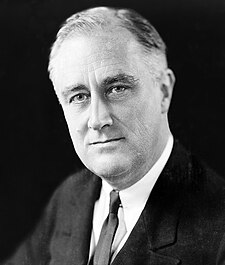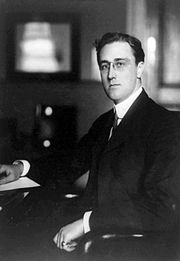Franklin Delano Roosevelt
From Kaiserreich
|
Franklin Delano Roosevelt (Hyde Park, New York, January, 30 1882 - Albany, New York, April, 12 1935) was an American politician of the Democratic Party. Governor of New York from 1929 to his assassination, he was the Vice-Presidential candidate in 1920 and the Presidential one in 1932, eventually losing to incumbent President Herbert Hoover.
Contents |
Biography
Early life
Franklin Delano Roosevelt was born on January 30, 1882 in the Hudson Valley town of Hyde Park. His father, James Roosevelt, and his mother, Sara Ann Delano, were each from wealthy old New York families, of Dutch and French ancestry respectively. Franklin was their only child.
Roosevelt grew up in an atmosphere of privilege. Sara was a possessive mother, while James was an elderly and remote father (he was 54 when Franklin was born). Sara was the dominant influence in Franklin's early years. Frequent trips to Europe made Roosevelt conversant in German and French. He learned to ride, shoot, row, and play polo and lawn tennis.
Roosevelt went to Groton School, an Episcopal boarding school in Massachusetts. He was heavily influenced by its headmaster, Endicott Peabody, who preached the duty of Christians to help the less fortunate and urged his students to enter public service. Roosevelt went to Harvard, where he lived in luxurious quarters and was a member of the Alpha Delta Phi fraternity. While at Harvard, his fifth cousin Theodore Roosevelt became president, and Theodore's vigorous leadership style and reforming zeal made him Franklin's role model and hero. In 1902, he met his future wife Anna Eleanor Roosevelt, Theodore's niece, at a White House reception. (They had previously met as children, but this was their first serious encounter.)
On March 17, 1905, Roosevelt married Eleanor despite the fierce resistance of his mother. Roosevelt entered Columbia Law School in 1905, but dropped out (never to graduate) in 1907 because he had passed the New York State Bar exam. In 1908, he took a job with the prestigious Wall Street firm of Carter Ledyard & Milburn, dealing mainly with corporate law.
Senator of New York
In 1910, Roosevelt ran for the New York State Senate from the district around Hyde Park in Dutchess County, which had not elected a Democrat since 1884. He entered the Roosevelt name, with its associated wealth, prestige and influence in the Hudson Valley, and the Democratic landslide that year carried him to the state capital of Albany, New York. Roosevelt entered the state house, January 1, 1911. He became a leader of a group of reformers who opposed Manhattan's Tammany Hall machine which dominated the state Democratic Party. Roosevelt soon became a popular figure among New York Democrats. Reelected for a second term November 5, 1912, he resigned from the New York State Senate on March 17, 1913.
Assistant Secretary of the Navy
|
Franklin D. Roosevelt was appointed Assistant Secretary of the Navy by Woodrow Wilson in 1913. He served under Secretary of the Navy Josephus Daniels. In 1914, he was defeated in the Democratic primary election for the United States Senate by Tammany Hall-backed James W. Gerard. As assistant secretary, Roosevelt worked to expand the Navy and founded the United States Navy Reserve. Wilson sent the Navy and Marines to intervene in Central American and Caribbean countries. In a series of speeches in his 1920 campaign for Vice President, Roosevelt claimed that he, as Assistant Secretary of the Navy, wrote the constitution which the U.S. imposed on Haiti in 1915. Advocating for a US intervention in the Weltkrieg, he was however promptly shut down.
Campaign for Vice-President
The 1920 Democratic National Convention chose Roosevelt as the candidate for Vice President of the United States on the ticket headed by Former Secretary of Treasury William Gibbs McAdoo of California, helping build a national base, and seemed to be able to win the election but the McAdoo-Roosevelt ticket was finally defeated by Republican Leonard Wood in the presidential election. Roosevelt then retired to a New York legal practice, but few doubted that he would soon run for public office again.
Health problems
In August 1921, while the Roosevelts were vacationing at Campobello Island, New Brunswick, Roosevelt contracted an illness, at the time believed to be polio, which resulted in Roosevelt's total and permanent paralysis from the waist down. For the rest of his life, Roosevelt refused to accept that he was permanently paralyzed. He tried a wide range of therapies, including hydrotherapy, and, in 1926, he purchased a resort at Warm Springs, Georgia, where he founded a hydrotherapy center for the treatment of polio patients.
Governor of New York
Roosevelt maintained contacts and mended fences with the Democratic Party during the 1920s, especially in New York. Although he made his name as an opponent of New York City's Tammany Hall machine, Roosevelt moderated his stance. He helped Alfred E. Smith win the election for governor of New York in 1922. Roosevelt gave nominating speeches for Smith at the 1924 and 1928 Democratic conventions. In 1928, as the Democratic Party presidential nominee in the 1928 election, Smith in turn asked Roosevelt to run for governor. While Smith lost the Presidency in a landslide, and was even defeated in his home state due to the increasing Syndicalist vote, Roosevelt was narrowly elected governor.
In the 1930 election campaign, to be re-elected, Roosevelt needed the good will of the Tammany Hall machine in New York City; however, his Syndicalist opponent was using Tammany Hall's corruption as an election issue. As the election approached, Roosevelt initiated investigations of the sale of judicial offices. He was elected to a second term by a margin of more than 700,000 votes.
1932 presidential election
Roosevelt's strong base in the most populous state made him an obvious candidate for the Democratic nomination, which was hotly contested since it seemed that incumbent Herbert Hoover would be vulnerable in the 1932 election. Al Smith was supported by some city bosses, but had lost control of the New York Democratic party to Roosevelt. Roosevelt built his own national coalition with personal allies such as newspaper magnate William Randolph Hearst, Irish leader Joseph Patrick Kennedy, and his former running mate, California leader William G. McAdoo. When Texas leader John Nance Garner switched to FDR, he was given the vice presidential nomination.
The election campaign was conducted under the shadow of the 1929 New York stock market crash, and the new alliances which it created. Roosevelt and the Democratic Party mobilized the expanded ranks of the poor as well as organized labor, ethnic minorities, urbanites, and Southern whites, crafting the New Deal coalition. During the campaign, Roosevelt said: "I pledge you, I pledge myself, to a new deal for the American people".
However, Roosevelt had refused to acknowledge the fact that the old political system, divided between Republicans and Democrats, had totally disappeared under the rises of the American First Union Party and the trade unions, not yet united under the Combined Syndicates of America. If Roosevelt gained the support of some Syndicalist moderates, the most extremist presented their own candidate, Norman Thomas, whose high score in the Manufacturing Belt impeached Roosevelt to secure the electoral vote there. The Pacific States, which were kept far from the economic crisis due to their tradings with Japan and Germany, recalled Hoover, such as the AFUP which presented their candidate in the South, Gerald Smith, just in order to eliminate Roosevelt, dubbed as too close of the Syndicalists.
Even if he received a wide popular vote, Roosevelt lost the election as the majority of the electoral vote was secured by the Republicans.
Assassination
|
Despite his electoral failure, Roosevelt retained his post of Governor of New York, despite the loss of the position of New York City mayor to a Syndicalist candidate in 1934. Hoping to run again for the 1936 Democrat Convention, he began to endorse more interventionist views, vehemently condemning the current isolationist policies of the US government and calling for cooperation with Canada against both Germany and Syndicalist Internationale, but instead claimed that the CSA economic proposals had to be considered in the interest of the United States. After the foundation of the CSA in February 1935, many anti-Syndicalists believed that Governor Roosevelt would defect from the Democrats to join them, influenced by his wife Eleanor.
Roosevelt didn't have the time to confirm these rumours: on April, 12 1935, an anarchist Italian immigrant living in New Jersey, Guiseppe Zangara, entered his office in Albany and shot him twice. As he was already incapacitated by his health problems, Roosevelt died quickly of a fatal hemorrhage, his last words being: "I have a terrific headache". Many consider that the horrible assassination of the former Democratic candidate to the White House was a break of the political violence in the United States.
Family
Franklin Roosevelt was fifth cousin to Theodore Roosevelt, who was President of the United States from 1901 to 1909, whose son Quentin pledged allegiance to the America First Union Party; the Roosevelt family is one of the wealthiest and oldest in New York State. Roosevelt met his fifth cousin once removed, Anna Eleanor Roosevelt, in 1902, and married her on March, 17 1905. They had six children in rapid succession:
- Anna Eleanor (born 1906)
- James (born 1907)
- Franklin Delano, Jr. (March 3, 1909–November 7, 1909)
- Elliott (born 1910)
- Franklin Delano, Jr. (born 1914)
- John Aspinwall (born 1916)
Some political experts claimed that Eleanor Roosevelt, now a widow, has expressed her support to the Syndicalist cause. The latter didn't express any denial.
Political career
- Member of the New York State Senate, 1911-1913
- Assistant Secretary of the Navy, 1913-1920
- Democratic vice-presidential candidate, 1920
- Governor of New York, 1929-1935
- Democratic presidential candidate, 1932



